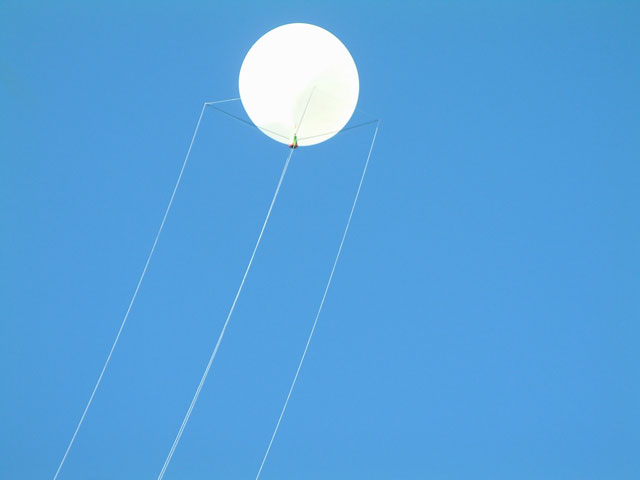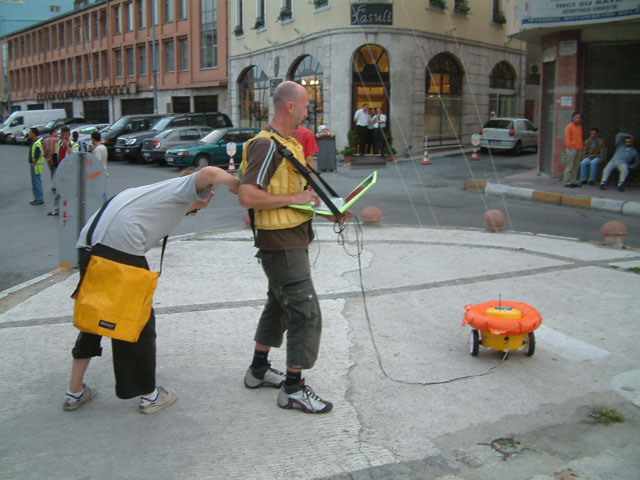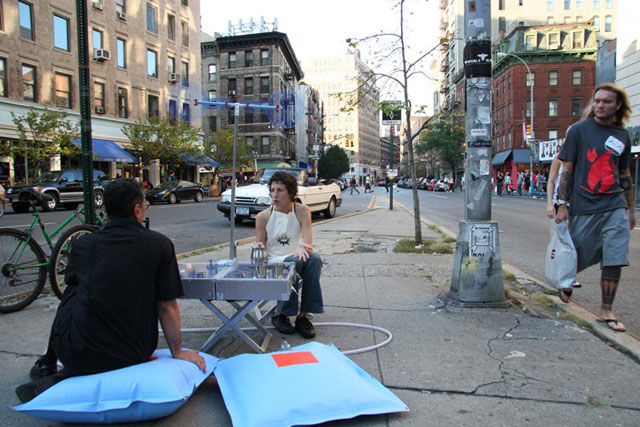VROOOOM VROOM - Contemporary vehicle design in Istanbul
by Heiko Hansen for Cluster Magasine, issue 06, Torino, Italy, November 2006

Marisa Jahn operating her “Crumb Meridian” through
Istanbul
The five days workshop VROOM: Vehicles of Registration and Omniscient Observational Mechanics, was held in Istanbul this September, as part of the Istanbul Fragmented conference, at the University for Architecture, in parallel with this years Contemporary Art Biennale. Otto von Busch, Evren Uzer and Klas Ruin invited six teams, who were already in the process of developing a vehicle for their hometown, to come and operate their vehicles in Istanbul.
I left from Paris with the mission to install “Tapis Volant”, a flying carpet on the Nostalgic tram track, which leads through the old town of Istanbul. The carpet had to be transported in a suitcase, as the regulation of the workshop was that the vehicle should not exceed the flight baggage limits. It is not easy to travel with a suitcase full of electronics on board of an airplane, but all of the participating teams eventually managed to arrive together with their projects in Turkey. There were:
“Crumb Meridian”, a hand buggy that
sows a line of bread crumbs through town, by Marisa Jahn and Steve Shada,
“View”, a helium balloon with birds eye view video
transmission by James Charlton and Sam Morrison,
“Disarm” by ATOPIA,
a suitcase that unfolds into a impromptu WiFi coffee bar,
“SMEE”, by Ossian Sunesson and Marcus Hannerstig
which records a mono wheel walk and “How do you do”
by Linus Elmes, Milo Laven and Elin Strand, which traversed Istanbul in
a straight line, and measuring everything that can be measured.

The helium balloon of “View” by James Charlton and
Sam Morrison

James and Sam operating “View”, the nervous robotic
vehicle which displays live video images from the airborne balloon.
Each group of artists operated, tested and performed with their vehicles in the city. This provided a strange spectacle for the inhabitants of Istanbul and also for the Vroomers, who had to find a balance, a fragile equilibrium, between physically moving through town and recording changes in perception, mixed with the flow of actual experiences, which could destabilise the moment of operation. “Crumb Meridian” encountered a difficult situation when one of its lines of breadcrumbs, lying in front of a Mosque, had to be cleaned away. The vehicles experimented along a thin line, being at times an attraction and sometimes crossing this line into the forbidden. But, none of these collisions where disengaging, as for any street theatre, if something is forbidden, it is not simply for what is does, but for a secondary cause, like in the case of one of the “View” balloon transmissions. It had to be dismantled at one point, after a request by the authorities, because it “attracted too many people”. But, this leads us to the intention of the vehicles, which are all opposed to a ubiquitous, standard viewpoint from which to experience and understand the city, offering a radical change in perspective. By giving an object a particular trajectory, for example to walk, to draw and to ride along conceptual, geographical and physical lines, to offer free coffee in exchange for conversation or to navigate by local aerial perspective, one can “measure the resistance of the city” as Linus, Milo and Elin Strand put it.

Lize Mogel, the coffee host of Atopia's “Disarm”,
offering coffee, a network and conversation in New York
This technique goes back to rudimental perceptional experiments of how we perceive the world, like inverting human vision through a mirror to see everything upside down. However, in the case of the vehicles, it is not the physical mirror that tilts, it is the existing, the culture that is tilted. “Crumb Meridian”, for example, recycles a buggy that is “traditionally used to leave lines of chalk on soccer fields”. The detournement of the object, to leave a line of bread crumbs, renders its function obscure, as much as it attracts birds and unsettles other lines of order in the city. The works are united by their intention to reinterpret reality. The reality provoked by the vehicles, even if it is experimental, would actually be a good tool for architects and town planners. Why not create tools to test and research our city as it is, to propose an architecture that not only seeks to build, but also to reprogram already existing spaces.
But this mirror can also show the dystopia of the city that appears in
public art in the moment where its realism points, intentionally or
not, at the brutality of city planning politics. Intentionally, in an
undeveloped part of Karaköy, the hectic street trading quarter
of Istanbul, not far from the famous Galata bridge spanning over the
Golden Horn. This undeveloped zone may be transformed into yet another
street of shopping and cocktail bars. Callum
Morton has simulated this vision by cladding a fully-fledged
LEVIS storefront onto one of the ruins, as part of an experimental
architecture event: the “Istanbul Pedestrian
Exhibitions”. Even though we cannot use, operate or enter his
architecture, the image remains long after and one hopes not only in
the minds of art critics and locals, but also for those who will
decide. But dystopia can also surface, unintentionally. For the same
event Ayse Emengen covered a cylindrical historic metal sculpture all
around with white polystyrene and transformed it into one huge white
cube. The morning I left Istanbul I found that the polystyrene had been
burnt down over night leaving a melted and twisted skeleton of its
armature, like the leftovers of the world trade centre in New York,
over heated and collapsed.

Heiko Hansen floating on a flying carpet that glides along the
Nostalgic Tram line along Istiklal
To complete my mission I operated the flying carpet on the Istiklal Boulevard, which unlike the grand boulevards in the Paris (the Istanbul of the West), alters between permanent construction and deconstruction. Even though, with a flying carpet, one can earn five-minutes of fame, the next sensation is already waiting. Hail Altindere one of the Biennale artists, filmed for his video a series of events on Istiklal, including a robbery of a gallery, a group of business man mutating into break dancers and a hooded gunman sneaking alongside the buildings, the latter without even getting noticed by the hectic stream of pedestrians!
In all these moments one thinks of the research paper “Siegfried Krakauer: Fragments of Marseilles”, that Henriette Steiner presented at the Istanbul Fragmented conference: “On one occasion, Krakauer remarks that the quality of a city can be measured by how many places it offers for improvisation.” In that sense Istanbul has richness, with which our over-organised western cities cannot compete.